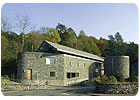
Over 13 tons of Burlington’s Elterwater roofing slate and dimensional stone has been incorporated within the Wordsworth Trust’s award-winning Jerwood Centre in Grasmere, Cumbria, England. Adjoining the grade II-listed Wordsworth Museum and close to Wordsworth’s former home, Dove Cottage, the new facility is now a permanent home to an unrivalled collection of books, manuscripts and artwork from Wordsworth and the Romantic period.
The original concept for the building came from architects Benson & Forsyth 15 years ago. At that time, the firm was asked to create a 21st Century building in the traditional materials of the U.K.’s Lake District. Moreover, the design would have to fit into a relatively difficult building site. Napper Architects, based in Newcastle-Upon-Tyne, were then appointed to take forward the concept and build the new center, which was recently completed.
The Jerwood Centre features Burlington’s pale green Elterwater slate laid in diminishing courses on the roof of the main building. The stone was quarried and produced locally by Burlington Slate, Ltd., which is also located in Cumbria.
“Burlington was an obvious choice, as the design of the building was to reflect the local vernacular, and Elterwater was the closest match to the slate used throughout the neighboring village,” explained Ian Wells of Napper Architects.
The same Elterwater stone was used for the building’s walls and adjacent rotunda, but in a more rough-hewn application. For these elements of the design, pieces of stone with the look of “quarry waste” were used as wall cladding. The installers of the project worked carefully to detail the stonework to appear as a dry stone wall. To add to the authenticity of the look, the lime mortar is kept 50 mm back from the face of the wall.
The three-story building includes a reading room on the top floor that houses many contemporary and significant editions of poetry. On the second floor, a cataloging and workroom provides a space where artwork and documents can be preserved, and the basement houses the remainder of the Wordsworth Trust’s collection of almost 60,000 letters, books, manuscripts, paintings and drawings. Meanwhile, the stone-clad rotunda is used for poetry readings, talks, lectures and small exhibitions.
In addition to providing a timeless look and seamlessly transitioning the building into its surroundings, the choice of natural stone also ensured that the facility would last for years to come. “This outstanding material offers the very long life qualities appropriate for a repository building designated to protect the internationally important Wordsworth manuscripts for future generations,” Wells said.
The project has been extremely well received since its completion. It has already received a commendation from the Civic Trust as well as a Royal Institute of British Architects (RIBA) Award - both of which seek out the highest quality in design that also makes a positive contribution to the local environment.